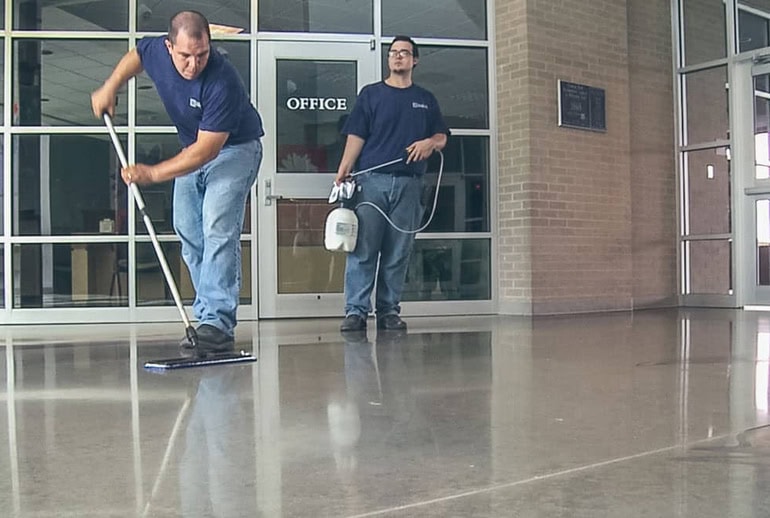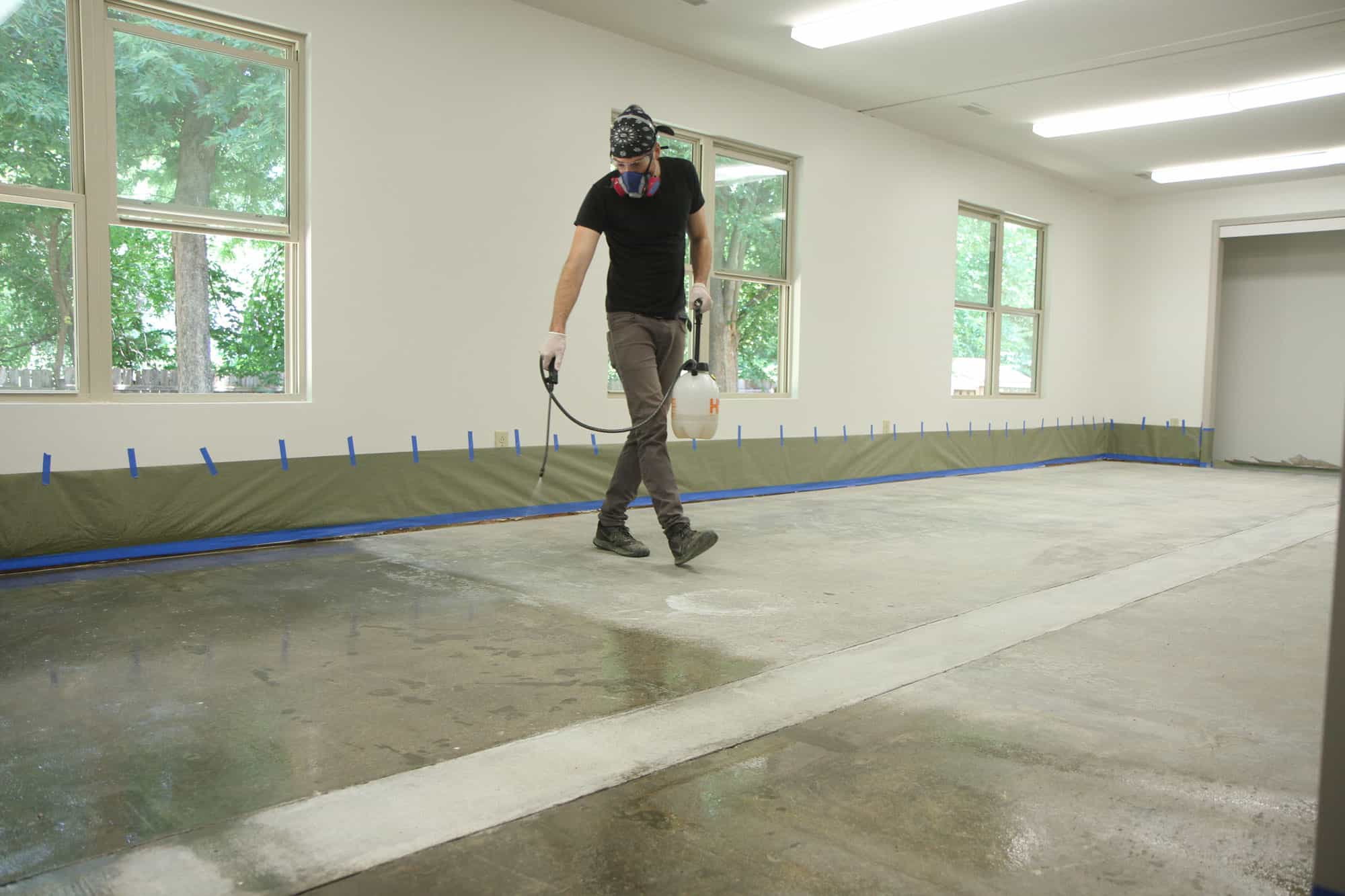Water, sunlight, and chemical exposure degrade unprotected concrete faster than most teams expect. Slabs break down, coatings fail, and surface integrity disappears long before the structure does. Choosing the right types of concrete sealers keeps those failures from starting in the first place.
Functional Groups: Film-Forming vs Penetrating
Concrete sealers fall into two broad categories: film-forming and penetrating.
- Film-forming sealers form a visible coat that adds gloss and prevents liquid water from penetrating the slab.
- Penetrating sealers absorb into the concrete’s pore structure, reacting chemically within the capillaries to reduce absorption while leaving the surface appearance unchanged.
Each group behaves differently when exposed to traffic, moisture, and environmental loading—foundational differences that define how types of concrete sealers perform in the field.
Acrylic Sealers for Decorative Applications
Acrylic sealers are among the most commonly used film-forming systems.
Water-Based Acrylics for Lower VOC and Faster Cure
These coatings tend to be lower in VOCs and dry faster, making them easier to apply in occupied spaces or areas with airflow restrictions. However, they often require reapplication sooner and may have less resistance to tire marking or chemical staining.
Solvent-Based Acrylics for Enhanced Color and Hardness
Solvent-based acrylics offer deeper color enhancement and improved surface hardness but come with stricter application conditions due to their higher VOC content and slower cure times. PROSOCO’s LSGuard is a topical treatment that offers this level of color enhancement and abrasion protection, especially when paired with densified slabs.
Polyurethane Sealers for Abrasion Resistance
Polyurethane coatings form a dense film over the surface and provide higher durability than acrylics.
Aliphatic and Aromatic Variants
Aliphatic polyurethane versions offer better UV stability and reduced yellowing over time. Aromatic versions may be limited to interior use due to color instability in sunlight. Among all types of concrete sealers, polyurethane coatings are often chosen when surface wear and impact resistance are top priorities.
Epoxy Sealers for Interior Chemical Control
Epoxy sealers offer a high-gloss, impervious coating that performs well in warehouses, labs, and other industrial interiors. These are typically two-part systems that must be mixed on-site and applied within a defined pot life.
Chemical Resistance and Moisture Limitations
Once cured, epoxy coatings form a hard, dense barrier that resists oil, solvents, acids, and physical impact. They trap moisture and can peel or blister if applied to damp concrete. Slip resistance is another factor that must be addressed, as high-gloss epoxies can become dangerously slick when wet unless grit or texture is added during the topcoat application.
Polyaspartic Sealers for Fast Turnaround
Polyaspartic systems are built for fast recoat windows, short return-to-service times, and flexible scheduling. Installers can apply them in cold weather or overnight without extending closure times. These systems are often selected when retail spaces, loading zones, or public walkways can't be out of use for long.
UV Stability and Single-Coat Coverage
These coatings offer strong resistance to yellowing and surface chalking, even under long-term sun exposure. Polyaspartics can be applied in thicker layers than most epoxies or urethanes, reducing labor steps. But their fast cure rate also demands experienced crews, since working time is limited and surface prep must be exact.
Silicate Sealers for Surface Densification
Silicate compounds chemically react with the concrete to produce calcium silicate hydrate (C-S-H), densifying the surface and reducing porosity.
- This reaction improves abrasion resistance and limits dusting by filling microvoids and hardening the wear layer.
- Because the treatment becomes part of the concrete matrix, it doesn’t peel, fade, or require reapplication.
- These sealers are used where abrasion resistance and dusting control are primary performance targets.
- They're often applied to warehouse slabs, big-box retail floors, and polished concrete surfaces that need long-term traffic durability without a surface film.
Most silicates are vapor permeable and work best when applied to clean, bare concrete with open pores.
Silane and Siloxane Sealers for Water Repellency

These penetrating sealers are commonly used in exterior assemblies exposed to driving rain or deicing agents. Instead of forming a surface film, they bond below the surface and change how the concrete interacts with water—causing it to bead up and run off. Their invisible finish leaves the texture and color unchanged, making them ideal for exposed architectural concrete and structural elements.
Field Behavior Based on Substrate Conditions
Silanes penetrate more deeply due to smaller molecules. Siloxanes form broader surface barriers. Both require clean, porous surfaces for effective application. If the concrete is too dense, sealed, or coated, the product won’t absorb properly and performance drops sharply.
Cure age, ambient humidity, and prep method all influence how well the treatment penetrates—and how long it lasts. Concrete Protector SB from PROSOCO is a silane/siloxane repellent designed for this use case—providing deep penetration and long-term water shedding.
Silicone Sealers for Temporary or Removable Use
Silicone-based sealers offer short-term water repellency without chemical bonding to cement paste. They are typically used on masonry, tile, or precast components where protection is needed without altering surface appearance. These products are vapor permeable and easy to remove or reapply, making them suitable for restoration jobs or areas where future recoating is expected.
These systems are selected when reversibility or temporary protection is required. They do not provide long-term resistance to abrasion or freeze-thaw cycling and are rarely used on structural concrete. Their main advantage is application speed and removability in sensitive restoration environments.
Hybrid Urethane-Acrylic Systems
Hybrids combine moisture tolerance with moderate durability.
- These coatings form a flexible film that can move with minor slab shifts while still offering some protection from surface wear.
- They dry faster and are easier to apply than full two-part systems, making them a good fit for light-duty commercial floors or interior slabs with intermittent use.
- They are often specified for slab areas subject to thermal cycling or light mechanical exposure.
While they don’t offer the hardness of epoxies or the UV stability of polyaspartics, they can extend service life in transitional environments where flexibility matters more than film thickness or gloss. Most hybrids can be recoated or repaired without grinding. PolishGuard, a film-forming protective coat from PROSOCO, performs similarly—offering gloss retention and chemical resistance on polished concrete floors.
Concrete Sealer Comparison by Exposure Condition
| Type | Water Repellent | Slip | Breathable | Typical Uses |
|---|---|---|---|---|
| Water-Based Acrylic | Moderate | High | Yes | Interiors, fast recoat |
| Solvent-Based Acrylic | Moderate | High | No | Stamped, colored slabs |
| Epoxy | High | V. High | No | Warehouses, labs |
| Polyurethane (Aliph.) | High | Mod | No | Decks, vertical surfaces |
| Polyaspartic | High | High* | No | Walkways, quick cure |
| Silicate | Low | Low | Yes | Densified/polished slabs |
| Silane/Siloxane | V. High | Low | Yes | Parking, exposed concrete |
| Silicone | Moderate | None | Yes | Temporary, restoration |
| Hybrid Urethane-Acrylic | Moderate | Mod | Limited | Light commercial, mixed areas |
*Add slip-reduction additive if needed.
Project Variables That Affect Sealer Performance
Different types of concrete sealers perform differently depending on jobsite conditions. Environmental exposure, substrate moisture, and occupancy requirements all affect how the sealer behaves once installed. Application success often comes down to matching the chemistry to field variables—not just the surface finish or spec line.
Moisture Vapor Transmission and Breathability
ASTM E96 data helps define which sealers are breathable. Below-grade and slab-on-grade assemblies often require breathable systems to prevent vapor pressure from building beneath the coating. Applying a vapor-blocking sealer in these conditions can lead to blistering or delamination, especially on slabs less than 30 days old. Understanding MVT thresholds helps avoid sealer failure in high-risk areas.
VOC Compliance and Regulatory Fit
Low-VOC sealers are required in schools, hospitals, and other occupied buildings, especially in regions governed by local emissions codes. Many states enforce limits under SCAQMD Rule 1113 or similar air quality rules. Water-based systems are often selected to meet these thresholds, but they may sacrifice gloss, durability, or recoat flexibility. VOC content should always be confirmed against project location and use case.
UV, Yellowing, and Gloss Retention
Direct sun can yellow or degrade many film-forming coatings, especially if they're based on aromatic urethanes or unprotected epoxies. Aliphatic polyurethanes and polyaspartics are more UV stable and hold their finish longer under full exposure. On rooftop decks, vertical concrete, and exposed plaza slabs, that UV resistance determines how long the system will look and perform as intended. Fading or gloss loss are early indicators of sealer breakdown.
Slip Resistance and Maintenance
Glossy coatings become slick when wet unless textured properly during application. Traction additives or aggregate broadcast layers are often needed for walkways, food prep zones, and loading docks. Maintenance also varies—some types of concrete sealers last years, while others may require recoating within 12 to 18 months. Product selection should account for cleaning cycles, use intensity, and safety expectations over the full service life.
Sealer Compatibility Within Full Systems

Installing a coating that’s incompatible with primers, densifiers, or cleaners can result in delamination or discoloration. The most common issues stem from residue left behind by prep products, mismatched pH levels, or overlapping cure times that interfere with bond development. Compatibility testing or manufacturer-approved system pairings are often required on projects with multiple chemistry layers.
Confirm Conditions Before Full Application
Always match sealers to substrate prep products and environmental conditions during application. That includes temperature, humidity, slab porosity, and any post-treatment steps such as burnishing or polishing. When in doubt, run a field test section before committing to full coverage—especially when combining products from different manufacturers or modifying application procedures.
Specify PROSOCO Sealer Systems That Match Surface and Exposure Conditions
Our sealers are developed for how concrete performs in the field—not just in the lab. Each formula is tested against jobsite realities like moisture intrusion, abrasion, UV load, and surface porosity. Contact us today for more information.